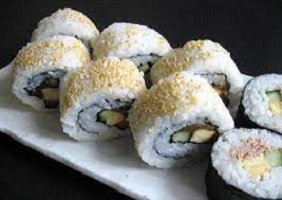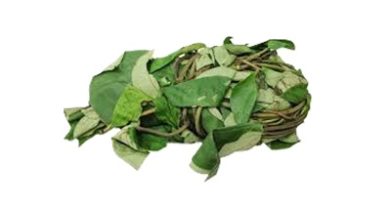Maki Roll: How to Make Maki Rolls
Maki Roll: How to Make Maki Rolls

There are many different types of sushi, but makizushi is one of the most popular in the United States (“maki” means “to roll,” and “zushi” is the conjugated version of “sushi”).
Because the sushi is rolled in dried seaweed called “nori,” this type of sushi is also known as norimaki.
Now that I think about it, they call them maki rolls in the United States, which is a bit redundant. I suppose we should call them nori rolls instead!
What is Maki Roll?
In Japanese, a maki roll is known as maki zushi, with “maki” referring to wrapping or coiling something and “zushi” referring to sushi (the word “sushi” becomes “zushi” when combined with other words).
Maki roll is a type of rolled sushi popular in Japan because it is simple to prepare at home and inexpensive to purchase in convenience stores.
Maki rolls are made with vinegared rice, seafood, and vegetables, as well as seaweed paper.
Rice and ingredients are placed on a square of seaweed paper and rolled into a cylindrical shape with a bamboo mat.
The bamboo mat aids in the creation of a perfect tube-like shape, as well as making the roll dense and durable.
Types of Maki Roll
Hosomaki: A very thin roll of sushi that is about 1 inch in diameter. Hosomaki is made with nori (seaweed paper), rice, and a single meat or vegetable ingredient.
Chumaki: Usually 1 1/2 inch in diameter and contains two or three different ingredients rather than just one as in the Hosomaki.
Futomaki: The largest of the maki rolls, Futomaki is typically 2 1/2 inches in diameter and can contain four or more ingredients in addition to rice and nori.
Uramaki: While most sushi rolls have nori as the outer layer, uramaki turns the sushi roll “inside out,” with the rice on the outside and the nori on the inside wrapping the ingredients.
Temaki: Also known as a “hand roll,” temaki is shaped like an ice cream cone and is designed to be eaten with one hand.
What is Sushi Rice?
Then you’ll need a sushi rice recipe. (Please continue reading.) We wouldn’t abandon you like that!)
To make sushi rice, you must first rinse the rice grains to remove any excess starch. This ensures that they cook up as fine, sticky grains instead of a starchy mess.
Rice vinegar, sugar, and a pinch of salt are used to season sushi rice. The rice will taste strange on its own, but trust us when we say that the sushi needs to be seasoned this way.
Special Tools in Making Maki Rolls
A bamboo rolling mat and nori (seaweed sheets) are required, and both can be found at World Market, Asian grocery stores, and some conventional grocery stores in the Asian section.
Sushi Fillings Selection
You’ll also require your sushi fillings.
We tend to avoid raw seafood when making sushi because sushi grade seafood (raw seafood that is safe to eat) is difficult to come by and expensive.
Cucumbers, avocado, imitation crab meat, cooked shrimp, red onions, scallions, green peppers, tomato, and mango are substituted instead.
Some of these fillings are more “traditional” than others, as you’ll notice. However, as long as you can cut it into nice long strips, you can use anything.
To Go with Sushi
Soy sauce, hot wasabi, and pickled ginger (all of which can be found with the nori at your grocery store) can be used to enhance the flavor of your sushi as you eat it.
However, they aren’t required for making sushi. Even without the finishing sauces, your sushi will be delicious.
Putting Together Everything
The most difficult part is combining all of the ingredients.
Make at least three rolls the first time you do it.
Why are three rolls required? It’s possible that your first is a little too big or too small. Getting the right amount of rice takes some trial and error.
Your second will be quite attractive.
By the third, you’ll be rolling sushi like a pro and wondering why you haven’t been doing it whenever you crave sushi!
Let’s Make Sushi Together!
- Place your nori on the bamboo rolling mat, shiny side down.
- Spread 1/3–1/2 cup sushi rice over 2/3 of the nori (from the short end). The rice layer should be about 1/8′′ thick. If the rice is too sticky to spread easily, wet your fingers first.
- Arrange your sushi fillings in a neat line about 1/3 of the way up the rice.
- We roll now
Gently pull the bamboo mat’s bottom section (with only 1/3 of the rice) up over the filling.
Roll the sushi again, this time pulling the mat straight away from you to get a nice roll.
Pick up the mat with the roll once it’s finished and press firmly. This will press the rice into place and seal the roll by sticking the last bit of nori to itself.
- Using a large, sharp knife, cut your roll. If things stick to the knife while you’re cutting, dampen it with a little water.
Sushi Fillings: More Options
Here are some sushi filling combinations!
- Crab, avocado, mango, and green pepper (California Roll)
- Avocado, tomato, red onion, and green pepper (Avocado, tomato, red onion, and green pepper)
- Mango and red onion (Sriracha Roll)
When considering a sushi filling combination, we like to include at least one creamy and one crunchy component. These provide a good texture base for maki sushi, and the rest of the flavors can be added later!
Sushi Rolling and Rice Instructions
Don’t be afraid to try your hand at sushi making. You’ll soon be rolling sushi like a pro and creating your own creative sushi fillings!
8 rolls per cup of rice
2-3 rolls per person as a serving suggestion
15-minute prep time
10 minutes to prepare
25 minutes total
Dinner course
Asian cuisine
4 person servings
Instructions
- Rinse rice thoroughly in a fine sieve until the water runs clear.
- Combine water and rice in a large saucepan. Bring to a boil, covered.
- Reduce to low heat and cook for 15 minutes.
- After 15 minutes, remove from heat and set aside for 10 minutes, covered.
- Whisk together vinegar, sugar, and salt in a small bowl until sugar dissolves.
- Pour over the rice and toss to coat.
- Allow rice to cool to room temperature before preparing sushi.
To make the Maki Rolls:
- Place your nori on the bamboo rolling mat, shiny side down.
- Cover 2/3 of the nori with 1/3 – 1/2 cup sushi rice (from the short end). The rice layer should be about 1/8″ thick. If the rice is too sticky to spread easily, wet your fingers first.
- Place the filling ingredients in a neat line 1/3 of the way up the nori, then gently pull the bamboo mat’s bottom section (with only 1/3 of the rice) up over the filling. Roll the sushi again, this time pulling the mat straight away from you to get a nice roll. Pick up the mat with the roll once it’s finished and press firmly. This will press the rice into place and seal the roll by sticking the last bit of nori to itself.
- Using a large, sharp knife, cut your roll. If things stick to the knife while you’re cutting, dampen it with a little water.
- If desired, top with pickled ginger, soy sauce, and/or wasabi.
Sashimi vs. Maki Roll
Sashimi is not a roll, but rather a thin slice of raw fish. Sashimi, unlike maki, does not include rice, nori, or vegetables.
Although a slice of raw fish may appear straightforward, mastering the technique can take years.
Daikon (Japanese radish), soy sauce, and wasabi are common accompaniments to sashimi.
Maki Roll vs. Nigiri
Nigiri is a type of sushi made by slicing a single piece of meat (fish, shrimp, scallops, etc.) and placing it on a hand-pressed rectangle-shaped block of rice. Between the rice and the fish, a small dab of wasabi is usually placed.
Hand Roll vs. Maki Roll
The distinctions between a Maki Roll and a Hand Roll
Maki rolls are cylindrical and cut into pieces, whereas hand rolls are cone-shaped and eaten with your hands.
Maki rolls come in two varieties (hoso maki and futo maki) and are rolled with a bamboo mat, whereas hand rolls are made with hands.
Recipe for Futo Maki Rolls
Sushi rolled into a thick, long cylinder is known as futomaki. Futomaki, which literally means “fat rolled sushi,” is a popular takeout sushi item.
The size of futomaki sets it apart from other types of sushi. Wide, thick, and stuffed with at least three ingredients, these popular sushi rolls are popular. Futomaki can be vegetarian, contain chunks of raw seafood, or even contain chicken, depending on personal preference.
A futomaki sushi roll can be difficult to roll due to its size and number of ingredients. Slicing the rolls can be challenging, and a very sharp knife is required to keep the rolls from falling apart. Kanpyo is a special ingredient found in most futomaki recipes.
Kanpyo is made from dried calabash shavings and is frequently cooked with sugar, soy sauce, and mirin. Other authentic fillings for futomaki include tamagoyaki, unagi, and Japanese cucumbers.
Futomaki Instructions (Futo Maki Roll)
Futomaki is a popular Japanese dish that is frequently served at festivals and picnics. Discover how to make these colossal sushi rolls.
Ingredients
Sushi Rice
- 225g uncooked Japanese short-grain rice,
- 270ml water,
- 1/2 piece kombu (dried kelp),
- 39ml sushi vinegar,
- 25g sugar,
- 4g sea salt
- ½ unagi, grilled OR our pre-grilled unagi kabayaki
- ½ bunch of rocket or watercress
- ½ cucumber
- ½ package sakura denbu or furikake as an alternative
Sushi Roll Wrapper
- 2 nori sheets
- 10 mL rice vinegar
- 60 mL water
Instructions
- Make long, thin strips out of tamagoyaki. Refrigerate the mixture until ready to use.
- Rinse the rice thoroughly and discard any excess water before making sushi rice. Fill a rice cooker halfway with cool water and add the rice. Allow the rice to soak for 20 to 30 minutes after adding the kombu.
- In a small saucepan, combine rice vinegar, salt, and sugar to make the sushi vinegar. Over medium-high heat, bring it to a boil. Use one of our artisan sushi vinegar or whisk until the sugar is completely dissolved.
- Spread the cooked rice evenly on the sushi oke to allow the rice to cool more quickly. Over the rice, pour the hot sushi vinegar. Toss the ingredients together gently with a rice paddle. To keep the rice from becoming mushy, use a hair dryer to help cool it.
- Preheat the oven for the unagi. Preheat the oven to grill mode (290°C/550°F) for three minutes.
To prevent sticking, line a baking sheet with aluminum foil and coat it with oil. Grill for six minutes after placing the unagi on the baking sheet. Allow cooling for a few minutes before cutting into four long strips.
- Chop the rocket or watercress coarsely and set it aside.
- Cut the cucumber in half lengthwise and remove the ends. Remove any remaining seeds.
- In a small bowl, pour the contents of the sakura denbu or furikake package. Place aside.
- In a small bowl, combine the water and rice vinegar to make vinegared water for your fingers to avoid sticking while assembling the futomaki.
- Place a nori sheet on a bamboo sushi mat, shiny side down. Half the sushi rice that has been prepared. Place one-half of the rice on the nori and spread evenly after dipping your fingers in the vinegared water. Leave a 1.5cm strip of nori along the top.
- Lay the cucumber on the nori’s bottom. To keep the sakura denbut and shiitake from falling out while rolling the sushi, place them near the top. All other ingredients, including the unagi, kanpyo, and rocket or watercress, should be placed on the bottom half of the nori.
- Carefully roll the nori forward while holding the top of the bamboo mat in one hand and the rolled mat in the other. Squeeze the roll tightly once completed.
- Using a very sharp knife, cut the futomaki in half. Cut each half into three or four pieces after that.
Easy Veggie Sushi Recipe: Kappa Maki Roll (Cucumber Roll)
The maki roll, also known as the cucumber roll, is one of the most well-known sushi rolls in the world.
Kappa roll is perfect for any occasion, whether it’s as an introductory sushi dish for newcomers or as a go-to for quick lunches.
Not to mention that making it at home is incredibly simple!
Questions Frequently Asked
What exactly is a veggie maki roll?
These vegetable maki rolls are a type of sushi that originated in Japan and consist of seasoned rice, shiitake mushrooms, and vegetables rolled up in a sheet of roasted seaweed and cut into bite-sized pieces.
They’re great for lunch at home or on the go! Course of appetizers
What exactly is a maki cut roll?
Cut rolls, also called maki, are made by rolling the ingredients into a long log and then cutting it into 6-8 bite-size pieces.
Hand roll sushi, also known as temaki, is a lot easier to make because it doesn’t require any cutting. Simply roll the ingredients into a cone to make a much larger portion.
How many pieces are there in a maki roll?
Maki is a type of cut-rolled sushi made by wrapping a sheet of nori around a layer of rice, vegetables, and fish, then rolling it up and cutting it into 6-8 pieces with a special bamboo mat.
You can choose from a wide range of maki sushi rolls in various sizes and styles.
Is eating maki roll healthy?
Salmon is high in omega-3 fatty acids and can be served on top of hand-pressed rice (nigiri sushi), in a roll (maki sushi), or in a variety of other ways.
However, you must be careful with the sauces and other items. They have the ability to increase fat and calorie intake.
Which maki roll is the healthiest?
The lowest calorie maki rolls are those made with vegetables or fish that don’t have any additional sauces or mayo, such as tuna or cucumber rolls, which have less than 200 calories per 6 pieces.
Salmon avocado and spicy tuna rolls have about 300 calories per roll.
What Does a Maki Roll Taste Like?
For example, makizushi, a type of sushi made from fish and vegetables wrapped in a sheet of crunchy nori or seaweed, can have a wide range of textures and flavors depending on the ingredients used by the sushi chef.
The saltiness and sweetness are in perfect balance.
What’s the distinction between sushi and a maki roll?
Maki is cylindrical sushi with toasted seaweed nori rolled around vinegared rice and a variety of fillings.
The main difference between Maki and Sushi is that Maki is a cylindrical type of Sushi, whereas Sushi can come in a variety of shapes.
What’s the best way to keep maki rolls fresh?
Fresh homemade sushi can be kept in the refrigerator for up to 24 hours. To do so, start by tightly wrapping each individual sushi roll in a clear film or plastic wrap.
Then put them in the refrigerator right away in a clean, dry container with an airtight lid.
Is it possible to refrigerate maki rolls?
Raw sushi can be kept at room temperature for up to 2 hours and refrigerated for 1–2 days, but cooked sushi can be kept in the fridge for 3–4 days.
Is it possible to eat maki rolls the next day?
Although the flavor and texture of the sushi may change (for example, softer sashimi, limp seaweed paper, and harder rice), there should be no harm in eating it 24 hours after it was prepared.
How long does Maki roll last?
Sushi comes in a variety of styles, and not all of them include raw seafood.
However, according to the experts, the answer to the question at hand is the same everywhere: Sushi can be stored in the refrigerator for up to 24 hours.


